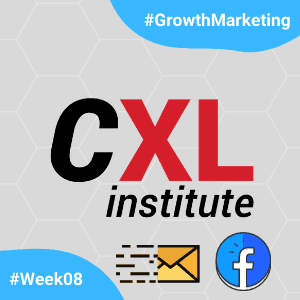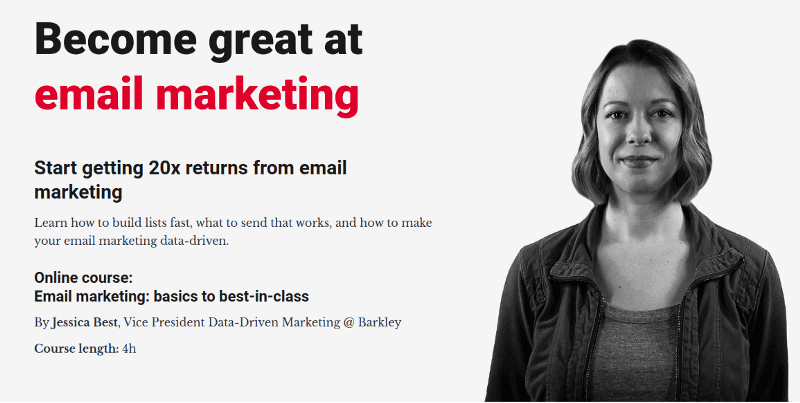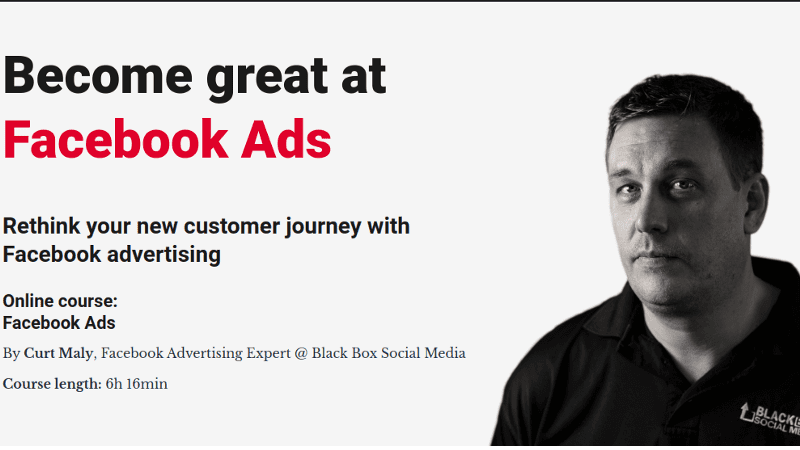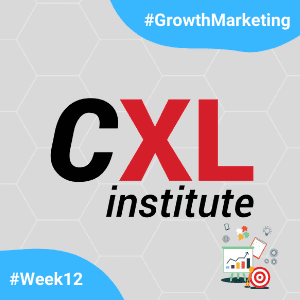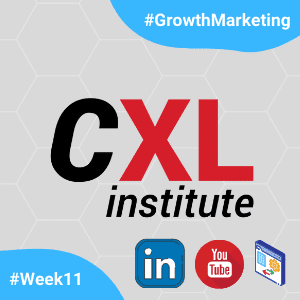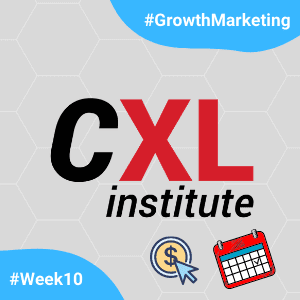Another week of studies on Growth Marketing Minidegree by the CXL Institute! I have finally reached the Channel-specific growth skills section, which provides a series of strategies on how to create and manage a growth in specific channels.
For the past 8 weeks, as part of the CXL’s Scholarship Program, I have been writing about my newly acquired knowledge on the topic of Growth Marketing. Until now, I have already written the following texts:
- Week 01: organization of the course and the relevance of the theme.
- Week 02: importance of carrying out growth experiments.
- Week 03: A / B tests and fundamentals of statistics for more assertive results.
- Week 04: Google Analytics for beginners. Main features, reports and analysis.
- Week 05: Intermediate Google Analytics. More advanced features, personalized views and methods to find solutions.
- Week 06: Google Tag Manager for Beginners. Basic features of an essential tool for collecting user behavior data.
- Week 07: Conversion Studies with courses on Landing Page Optimization, to create pages that convert, and Product Messaging, to send the right message.
The section I started studying this week is certainly the densest in Minidegree. In addition to being extensive in duration, the themes have some degree of technical complexity, which requires a little more attention and dedication. In order to organize the section efficiently, the section is divided into 13 specific courses, in addition to 2 event videos. The courses that make up this section are the following:
- Email marketing: by Jessica Best, lasting 4 hours.
- Messaging strategy in public relations: by Ray Young, 23 min long.
- Facebook Ads: by Curt Maly, 6 hours long.
- Google Ads: by Johnathan Dane, 2 hours long.
- Content strategy and SEO for lead generation: by Andy Crestodina, with a duration of 6h30.
- Retention: the most underrated growth channel: by Val Geisler, lasting 3 hours.
- Maximizing audiences for your PPC campaigns: by Michelle Morgan, 6 hours long.
- SEO driven editorial calendar: by Dan Shure, 3 hours long.
- LinkedIn advertising: by AJ Wilcox, lasting 3 hours.
- YouTube Ads: by Tom Breeze, 3 hours long.
- Technical SEO: by Martijn Scheijbeler, lasting 2h30.
- Data-driven influencer marketing: by Siim Säinas, lasting 3 hours.
- Account based marketing: by Steve Watt, lasting 3 hours.
The event videos are:
- Content as a growth engine: by Sujan Patel
- How IMPACT used ResearchXL model to 3X conversions from content marketing: by Bob Ruffolo
There are almost 50 hours of technical content in this section alone!
For this week, I chose to study the first three courses: Email Marketing, Messaging strategy in public relations and Facebook Ads. Below, I have listed some of the main points about each of the courses and event videos:
Email Marketing: from basics to best-in-class
The course Email Marketing CXL Institute is taught by Jessica Best, Vice President Data-Driven Marketing @ Barkley. In approximately 4 hours, she explains how to build lists and send relevant content to users using data-driven strategies. Email, even today, is one of the channels with the highest return on investment. Jessica shows, in 4 classes, how to get the best out of this channel.
In the first part of the course, Email Marketing Basics, Jessica shows some of the best practices in sending emails, with tips on what should always be done and what should be avoided, in order to avoid being marked as SPAM, not have compatibility problems with different devices and respect privacy limits.
In the second class, How to Optimize Your Email Marketing List Growth, the instructor shows some of the main alternatives, free or paid, to grow the list of subscribers to an email list.
Following the good practices of the first class and using the user confidence acquired in the second, the Optimizing Email Marketing Copy & Design class serves to complete the writing of the email with a pleasant design. In this part, Jessica also presents some of the trends to test in different campaigns.
Finally, the last class, Using Data to Drive Email Marketing Relevance and Results, deals with the analytical part of sending emails. In addition, Jessica shows how to take advantage of having a channel in which the capacity for personalization is very high, enabling direct contact with the user.
Messaging strategy in public relations
The short course taught by Ray Young deals with some of the fundamentals in Public Relations, showing how the theme is closely related to Digital Analytics and Content Marketing. Ray shows how to establish connections with the public through a consistent message, which allows to create strategies for dissemination and positioning in the press and other members of the media.
Facebook Ads
The course on Facebook Ads,taught by Curt Maly, shows in little more than six hours in length, how to build an ad strategy consistent and avoid expending resources inefficiently. Curt presents a framework for building the marketing strategy (BELT), shows how to structure scalable campaigns that bring results, teaches how to use Lives on Facebook to segment audiences and, finally, explains how to test creative and cost effective alternatives.
The course has 20 lessons, which can be divided into 3 sections: The BELT Method, Ads & Content and Facebook Strategies. In the first part, Curt presents the framework to discover the journey of the new user. The framework is based on 4 pillars: Belief, Engage, Lead and Transact. With the presented method, it is possible to align messages and objectives with the needs of the audience, in addition to building the best audiences in a consistent and even automatic way.
In the second part, on Ads & Content, techniques are presented to create content and ads that have the greatest impact with the audience. Curt shows tools that help in the creation of relevant and converting content, in addition to showing how simple, low-cost videos can generate high engagement. Finally, we see how to use Facebook Lives to promote products and services, as well as how to build a highly targeted audience with this tool.
The final part of the course deals with Facebook Strategies. In this part, Curt shows alternatives to test audiences and content with low cost and little complexity. Next, we see how to increase the relevance of the content advertised and, consequently, reduce costs. Finally, we see how to create scalable and performance alternatives.
Next week…
For the next week, I will continue my studies within the Channel-specific growth skills section, advancing to major Google channels, with courses on Google Ads for SEM (Search Engine Marketing) and Content strategy and SEO for lead generation for SEO (Search Engine Optimization).
See you next week!
